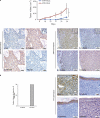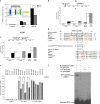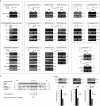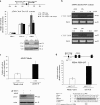Cdc6 expression represses E-cadherin transcription and activates adjacent replication origins
- PMID: 22201124
- PMCID: PMC3246883
- DOI: 10.1083/jcb.201108121
Cdc6 expression represses E-cadherin transcription and activates adjacent replication origins
Abstract
E-cadherin (CDH1) loss occurs frequently in carcinogenesis, contributing to invasion and metastasis. We observed that mouse and human epithelial cell lines overexpressing the replication licensing factor Cdc6 underwent phenotypic changes with mesenchymal features and loss of E-cadherin. Analysis in various types of human cancer revealed a strong correlation between increased Cdc6 expression and reduced E-cadherin levels. Prompted by these findings, we discovered that Cdc6 repressed CDH1 transcription by binding to the E-boxes of its promoter, leading to dissociation of the chromosomal insulator CTCF, displacement of the histone variant H2A.Z, and promoter heterochromatinization. Mutational analysis identified the Walker B motif and C-terminal region of Cdc6 as essential for CDH1 transcriptional suppression. Strikingly, CTCF displacement resulted in activation of adjacent origins of replication. These data demonstrate that Cdc6 acts as a molecular switch at the E-cadherin locus, linking transcriptional repression to activation of replication, and provide a telling example of how replication licensing factors could usurp alternative programs to fulfill distinct cellular functions.
Figures










Similar articles
-
Protein phosphatase 2A is targeted to cell division control protein 6 by a calcium-binding regulatory subunit.J Biol Chem. 2008 Jun 6;283(23):16104-14. doi: 10.1074/jbc.M710313200. Epub 2008 Apr 8. J Biol Chem. 2008. PMID: 18397887 Free PMC article.
-
CUL4B promotes replication licensing by up-regulating the CDK2-CDC6 cascade.J Cell Biol. 2013 Mar 18;200(6):743-56. doi: 10.1083/jcb.201206065. Epub 2013 Mar 11. J Cell Biol. 2013. PMID: 23479742 Free PMC article.
-
Oncogenic activity of Cdc6 through repression of the INK4/ARF locus.Nature. 2006 Mar 30;440(7084):702-6. doi: 10.1038/nature04585. Nature. 2006. Retraction in: Nature. 2017 Jul 12;547(7662):246. doi: 10.1038/nature23287. PMID: 16572177 Retracted.
-
Cdc6: a multi-functional molecular switch with critical role in carcinogenesis.Transcription. 2012 May-Jun;3(3):124-9. doi: 10.4161/trns.20301. Transcription. 2012. PMID: 22771947 Free PMC article. Review.
-
Cdc6 as a novel target in cancer: Oncogenic potential, senescence and subcellular localisation.Int J Cancer. 2020 Sep 15;147(6):1528-1534. doi: 10.1002/ijc.32900. Epub 2020 Feb 17. Int J Cancer. 2020. PMID: 32010971 Free PMC article. Review.
Cited by
-
Epstein-Barr nuclear antigen 1 (EBNA1)-dependent recruitment of origin recognition complex (Orc) on oriP of Epstein-Barr virus with purified proteins: stimulation by Cdc6 through its direct interaction with EBNA1.J Biol Chem. 2012 Jul 6;287(28):23977-94. doi: 10.1074/jbc.M112.368456. Epub 2012 May 14. J Biol Chem. 2012. PMID: 22589552 Free PMC article.
-
Epigenetic landscape for initiation of DNA replication.Chromosoma. 2014 Jun;123(3):183-99. doi: 10.1007/s00412-013-0448-3. Epub 2013 Dec 17. Chromosoma. 2014. PMID: 24337246 Review.
-
Cdc6 cooperates with c-Myc to promote genome instability and epithelial to mesenchymal transition EMT in zebrafish.Oncotarget. 2014 Aug 15;5(15):6300-11. doi: 10.18632/oncotarget.2204. Oncotarget. 2014. PMID: 25051368 Free PMC article.
-
Exploring the role of exosomal MicroRNAs as potential biomarkers in preeclampsia.Front Immunol. 2024 Mar 19;15:1385950. doi: 10.3389/fimmu.2024.1385950. eCollection 2024. Front Immunol. 2024. PMID: 38566996 Free PMC article. Review.
-
Deregulated expression of Cdc6 in the skin facilitates papilloma formation and affects the hair growth cycle.Cell Cycle. 2015;14(24):3897-907. doi: 10.1080/15384101.2015.1120919. Cell Cycle. 2015. PMID: 26697840 Free PMC article.
References
-
- Bartkova J., Rezaei N., Liontos M., Karakaidos P., Kletsas D., Issaeva N., Vassiliou L.V., Kolettas E., Niforou K., Zoumpourlis V.C., et al. 2006. Oncogene-induced senescence is part of the tumorigenesis barrier imposed by DNA damage checkpoints. Nature. 444:633–637 10.1038/nature05268 - DOI - PubMed
Publication types
MeSH terms
Substances
LinkOut - more resources
Full Text Sources
Other Literature Sources
Molecular Biology Databases
Miscellaneous

